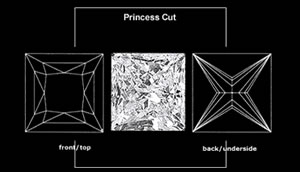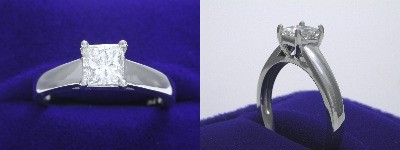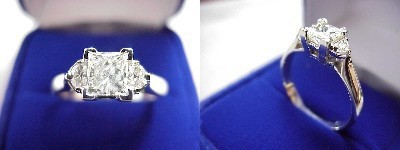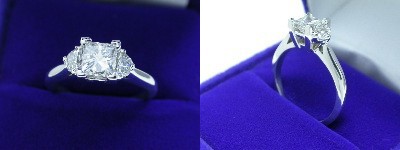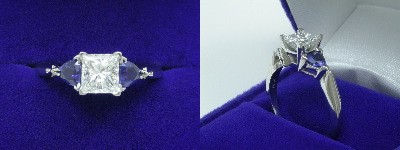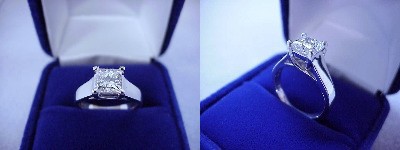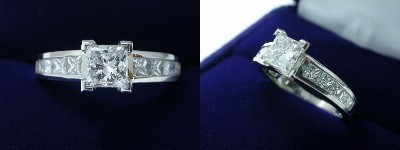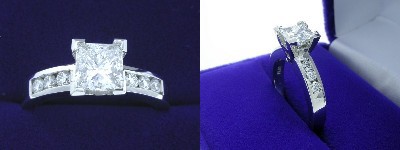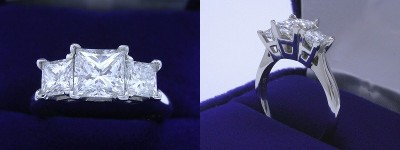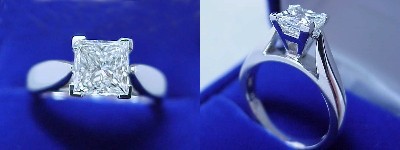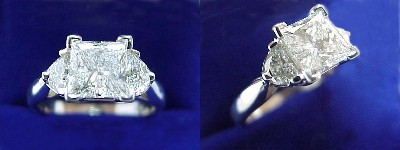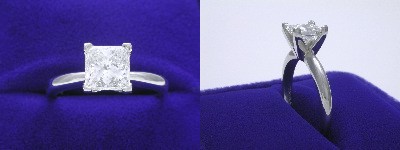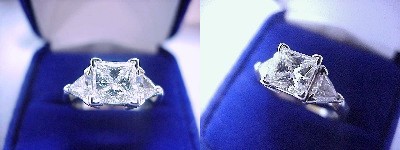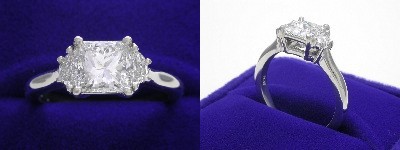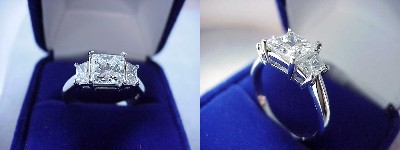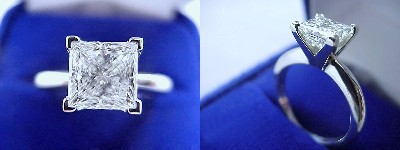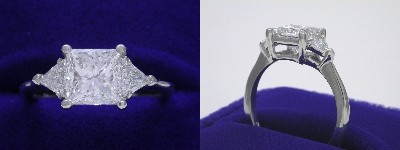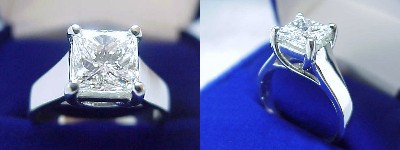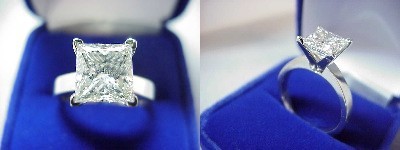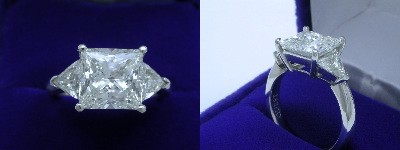The princess is a brilliant-style shape with sharp, pointed, uncut corners. It is typically square in appearance (length-to-width ratio 1.05 or less), rather than rectangular.
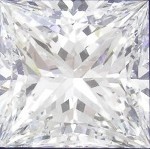 Brilliant style refers to vertical-direction crown and pavilion facets instead of the older, step-style horizontal-direction facets. It is a straight-edged square with pavilion facets that are wide at the culet (bottom of the diamond) and narrowed toward the girdle, the opposite of the pavilion-facet arrangement on the cut-cornered radiant.
Brilliant style refers to vertical-direction crown and pavilion facets instead of the older, step-style horizontal-direction facets. It is a straight-edged square with pavilion facets that are wide at the culet (bottom of the diamond) and narrowed toward the girdle, the opposite of the pavilion-facet arrangement on the cut-cornered radiant.
 The princess was developed in 1980 by Betzalel Ambar and Israel Itzkowitz, of the Los Angeles based Ambar Company. At the time the princess cut was invented it was considered avant garde but is now one of the most popular diamond shapes.
The princess was developed in 1980 by Betzalel Ambar and Israel Itzkowitz, of the Los Angeles based Ambar Company. At the time the princess cut was invented it was considered avant garde but is now one of the most popular diamond shapes.
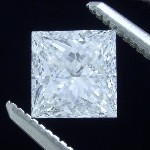 Cutting a princess generally results in a yield of 60 to 62 percent of the weight of the rough crystal, which is a better weight retention than a round. Often the octahedron rough crystal can be sawn in half, yielding two princess from one stone sawn surfaces becoming the tables of the two resulting princess stones. The high yield in weight translates into lower prices for princess cut diamonds compared to round brilliants.
Cutting a princess generally results in a yield of 60 to 62 percent of the weight of the rough crystal, which is a better weight retention than a round. Often the octahedron rough crystal can be sawn in half, yielding two princess from one stone sawn surfaces becoming the tables of the two resulting princess stones. The high yield in weight translates into lower prices for princess cut diamonds compared to round brilliants.
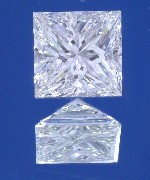 The princess cut is called a square or rectangular modified brilliant in GIA grading reports. It may have either 50 facets (21 crown, 4 girdle, 25 pavilion) or 58 facets (21 crown, 4 girdle, 33 pavilion), depending on how the pavilion is cut. This cut is most frequently a square shape where the length to width ratio is 1.05 or less.
The princess cut is called a square or rectangular modified brilliant in GIA grading reports. It may have either 50 facets (21 crown, 4 girdle, 25 pavilion) or 58 facets (21 crown, 4 girdle, 33 pavilion), depending on how the pavilion is cut. This cut is most frequently a square shape where the length to width ratio is 1.05 or less.
The princess is the standard brilliant-style square cut found in both channel and invisibly set diamond jewelry using stones 0.25 carats or fewer. It has replaced traditional rounds in many cases.
The princess cut tends to be one of the smallest of the shapes for the same carat weight since the cut is basically an upside-down pyramid with most of the carat weight in the pavilion. Princess cut diamonds with larger total depth percentages are much smaller in length and width than lower depth stones.
 Because the corners of the princess cut were at the outer edges of the rough diamond crystal, this is where you can often expect naturals, inclusions and extra facets. Since the corners of a princess cut are usually covered by a V-shaped prong, irregularities at the corners are often not visible once set. However, these same irregularities can also lead to durability problems. The sharp, squared-off corners of the princess cut require great care when setting and need to be protected to avoid chipping or cracking.
Because the corners of the princess cut were at the outer edges of the rough diamond crystal, this is where you can often expect naturals, inclusions and extra facets. Since the corners of a princess cut are usually covered by a V-shaped prong, irregularities at the corners are often not visible once set. However, these same irregularities can also lead to durability problems. The sharp, squared-off corners of the princess cut require great care when setting and need to be protected to avoid chipping or cracking.
Advice: We recommend princes cut diamonds with a depth of 58-76% and table of 58-77%, with smaller depth and table percentages preferred. Deeper princess cuts are very small in length and width for the same carat weight. Look for lots of brilliance. We recommend at least H color and SI1 clarity for princess cut diamonds.
When putting together a three stone ring with a princess cut diamond in the center, a ratio of 1.05 to 1.08 looks great. The side stones widen the diamond look so the longer side on the center diamond yields a bigger appearance.
As long as the polish and symmetry are at least Good, these minor finish grades are not significant factors in affecting the appearance of a princess cut diamond.
The following photos are only a sampling of princess cut diamond ring styles. Hundreds of mounting styles look great with princess cut diamonds so just email us a picture of the style you like and we can get you a price quote. You can also check out our Designer Gallery for pictures of mountings from some of our suppliers.

